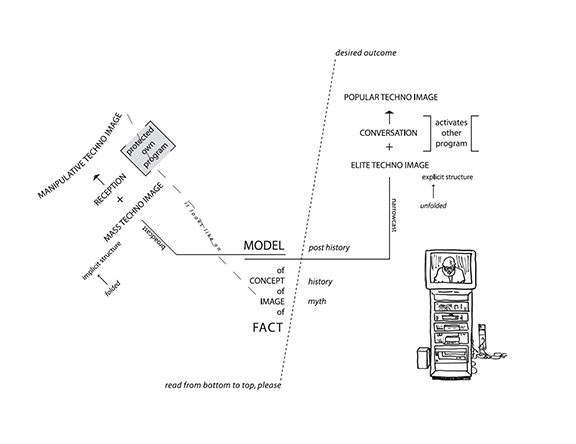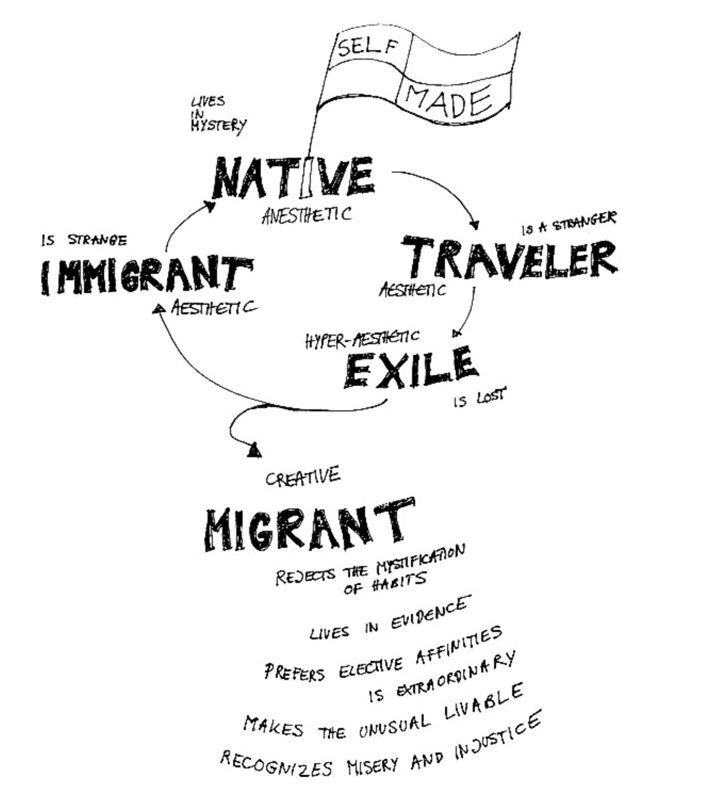


While I read Flusser's writings I had access to (those published in German and in English) and diagrammed a few, there are two, surprisingly parallel ideas I regularly refer to. Both juxtapose a situation that relies on an occluded ground (the native and the mass technical image) with a transparent, dialogic construct (the migrant and the elite technical image.)
What initially intrigued me was his twofold construct of the technical image, as an 'elite technical image' that lives in dialogue, as a blueprint or diagram, or a 'mass technical image' that obscures its origin, which is the apparatus - operator complex. Here, Flusser talked about photography. This helped me to assess what it means to diagram, namely to produce a dialogic image, and led to the notion that criticality is at its core contextualization, a clarification of perspectives and interests.
The second notion is expressed in his essay "Exile and Creativity", speaking of the onus to make oneself. Again a movement from a mythical ground or origin is invoked: a movement from the condition of the native who lives in mystery, to a state of transparency and self-realization in the migrant who lives in evidence.
The first diagrams I made reading Flusser contained photographic backgrounds, were printed on vinyl, 3' x 3', exhibited in the US and at Jan Frühsorge's Galerie für Zeichnung in Berlin (2003), and at the Vilém Flusser Archive, which was then housed at the Kunsthochschule für Medien (KHM) in Cologne. A full set became part of the Flusser archive.
I made a small group of drawings then, overlaying inkjet test prints with acetate to freely sketch on top of the prints with markers. Those foreshadowed the later use of Whiteboards, driven by the desire to support the diagram's dialogic life.
The first issue of Bootprint, 2007 contains my translation of Vilém Flusser's lecture Krise der Linearität (Crisis of Linearity) and an artist statement in which I talk about making diagrams, in relation to Flusser's writing, Stalking the Continuum, p.18 - 21.
I revisited some of the material later: Reading Vilém Flusser in North America: Self-made, Do-it-yourself and Doing-it-together, in Temporary Art Review.
When I edited the book, Useful Pictures, the title took its cues from Flusser, as my introduction also stated. Useful Pictures later became the name of my blog.
Art historian Astrit Schmidt-Burkhardt discusses how Flusser appears in my work in this twice-published essay: Schmidt-Burkhardt, Astrit; Unter dem diagrammatischen Imperativ. Book chapter on A. Mers, Ward Shelley and Jeremy Deller; in Die Kunst der Diagrammatik, transcript Verlag, 2012 and in Susanne Leeb, ed.; “Diagramme in der Kunst des 20. und 21. Jahrhunderts”, b_books, Berlin, 2011
The Exile and Creativity Whiteboard was produced as one of 5 diagrams, part of a performance lecture series, within an exhibition at the Museum of Contemporary Art, Chicago, in 2011.
It continues to be used, most recently as part of the Talking Whiteboards conversations. It is also included in a laminated diagram collection that can be used with wet-erase markers, part of the exhibition, WOUND, at Cooper Union, New York, 2016.
Where the idea of the technical image has recently become important in a new way is in my collaboration with programmer Robert Woodley. As we created the Face Field Project, it became apparent that we were producing a 'mass technical image', including a face synthesizer and an app. Synth Face prints were exhibited in the exhibition Enter The Matrix, at the Chicago Cultural Center, in 2014. Flusser comes up in this video of an artist talk at the exhibition, about 43 minutes into it. This exploration of a mass technical image production scheme does have a diagrammatic backend.